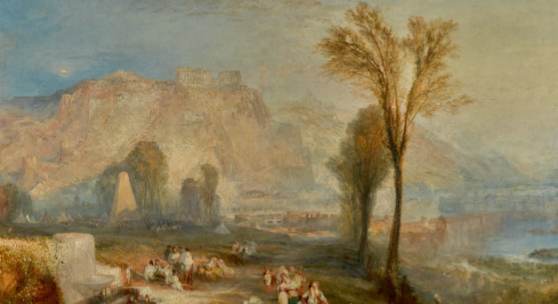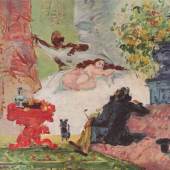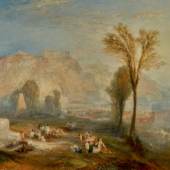Sotheby’s London
One of the Greatest Works by Turner Still in Private Hands Comes to the Market
-
Auktion05.07.2017
A crucial work of the artist’s great, late period, Turner’s Ehrenbreitstein was hailed as a masterpiece by his contemporaries, and also had special personal significance for him. With its remarkable provenance, it is the most important of all his German views, and one of his greatest paintings. “The finest Turner I have come across for many a day” JOHN RUSKIN, 2 MAY 1844
LONDON, 4 April 2017 – In July this year, Sotheby’s will offer for sale one of the greatest works by J.M.W. Turner still in private hands. Painted in 1835, Ehrenbreitstein is a late work, dating from a period that is widely considered Turner’s best: other works from this time now hang in the world’s greatest museums, with only a minute number of this importance and quality remaining in private ownership. The subject of enormous critical acclaim when it was first exhibited in 1835, the painting depicts the ruined fortress of Ehrenbreitstein near Coblenz – a place of special significance for Turner. Though he made many drawings and watercolours of German views, this is the most important oil painting of a German subject that Turner ever painted. The picture will be offered at Sotheby’s in London on 5th July with an estimate of £15-25 million (US$18.7-31.2m / €17.3-28.9m).
Often referred to as the ‘painter of light’, Turner is widely regarded as Britain’s foremost artist, whose unique and unprecedented style not only had a profound and lasting impact on British art, but was also a vital precursor to both the Impressionist and the much later Abstract Expressionist movements. (Monet openly acknowledged his indebtedness to Turner.) Major works of such astounding quality by Turner are rare on the international market. The last example to be offered (Rome, from Mount Aventine, painted in the same year as Ehrenbreitstein and offered at Sotheby’s in 2014) made a record £30.3 million/ $47.6 million – the highest price ever achieved for any British-born artist at auction, and placing Turner alongside Rubens and Raphael as one of just three artists from the pre-Impressionist era to have achieved prices at this level.
Julian Gascoigne, senior specialist in British Paintings, said: “Turner is one of those seminal figures who changed the way we see and think about the world. An artist rooted in the aesthetic philosophy and culture of his time, perpetually engaged with the art of both his predecessors and contemporaries, he was at the same time possibly the first ‘modern’ painter; who directly inspired the Impressionism of the nineteenth century, and presaged the Abstract Expressionism of the twentieth. These late works in particular, with their bold application of colour, treatment of light and deconstruction of form, revolutionised the way we perceive the painted image. By applying the techniques of a watercolourist to the use of oils, with successive layering of translucent colour thinly applied to the surface, which imbue his canvases with rich, hazy light, he gave his works an unprecedented poignancy and power that has rarely been rivalled since.”
Alex Bell, Co-Chairman of Sotheby’s International Old Masters Department, added: “This painting was one of five that Turner exhibited at the Royal Academy in 1835; the other four of which are now in some of the most distinguished institutions in the world. Of those five paintings, it was Ehrenbreitstein that caught the imagination of public and critics alike – and it’s easy to see why. Its extraordinary range and depth of colour, and typically inspired and imaginative use of light, would in any case mark this painting out as a masterpiece, but its true greatness lies in the way Turner applies his painterly genius to transform the ruins of the famous fortress into a poetic and symbolic image as resonant then as it is today.“
The area of the Rhine, and especially the fortress of Ehrenbreitstein, held particular resonance for Turner. He first visited the area in 1817 and would return many times over the years, producing countless drawings in his sketchbooks and numerous watercolours. This painting relates specifically to a series of sketches he produced during his third tour of Germany in 1833, when he travelled down the Rhine en route to Vienna and then Venice, via Salzburg.
GENESIS AND PROVENANCE
The painting was originally painted for the illustrious publisher John Pye, a close friend of Turner’s, as the basis for a large single plate engraving – one of the important select series of large prints by which the artist established his contemporary celebrity. Pye had anticipated the artist would produce a watercolour, along the lines of Turner’s previous Rhineland views. When it came to it, however, so engaged with the beauty and symbolic resonance of the subject was Turner that he felt he could only do justice to its scale and grandeur in oil, with all its depth of emotional power and complexity of diaphanous light. What he delivered to Pye was this magnificent 93cm x 123cm full Royal Academy exhibition oil painting.
Turner’s unanticipated rendering caused Pye a good deal of frustration – working up an engraving from a painting of this size and complexity was not the easiest of tasks, taking some eleven years to complete, with a number of terse exchanges along the way.
-
Der deutsch-französische Krieg beeinflusst natürlich auch das künstlerische Leben...
-
23.01.2025 - 30.01.2025Vom 23. bis 30. Januar 2025 präsentiert Sotheby’s eine außergewöhnliche Online-Auktion zu...
-
24.01.2025 - 31.01.2025Sotheby’s in Paris veranstaltet bis zum 31. Januar 2025 eine außergewöhnliche online...
-
06.03.2025Sotheby’s, eines der weltweit führenden Auktionshäuser, beginnt das Jahr 2025 mit einer...
-
05.07.2017Auktion »
EHRENBREITSTEIN - TRAVELLING EXHIBITION:
Cologne: Los Angeles: New York: Hong Kong: Paris:
5th April
1st - 3rd May (by appointment) 5th - 15th May
25th - 31st May
10th - 12th June














